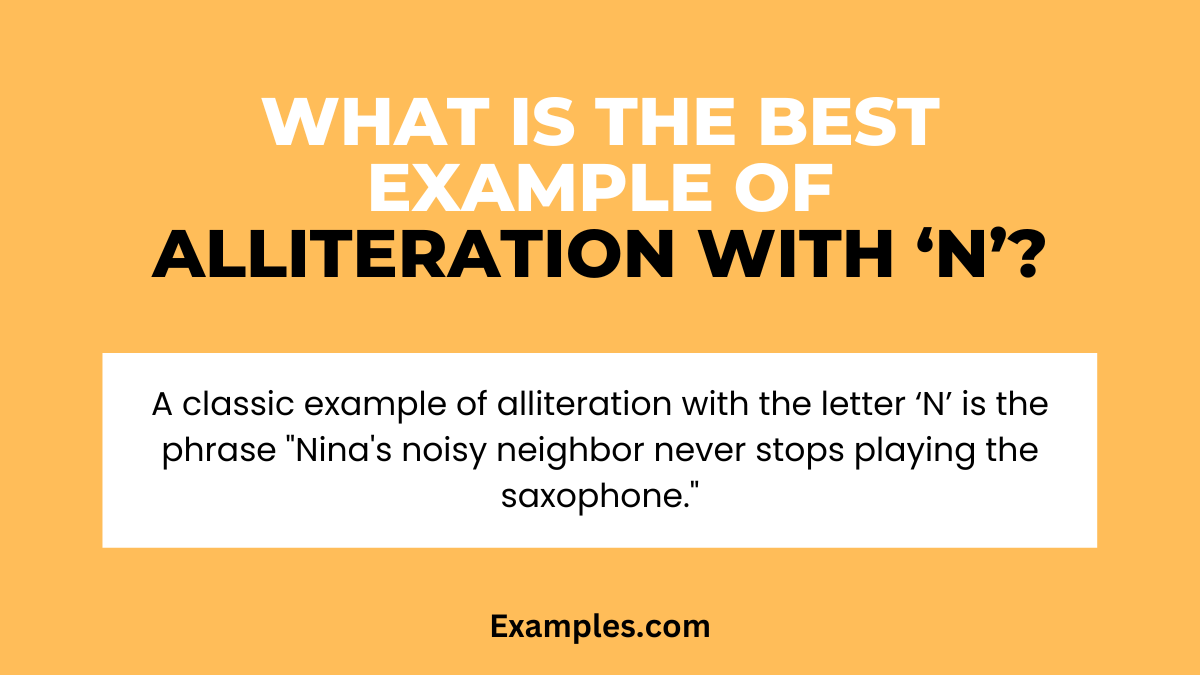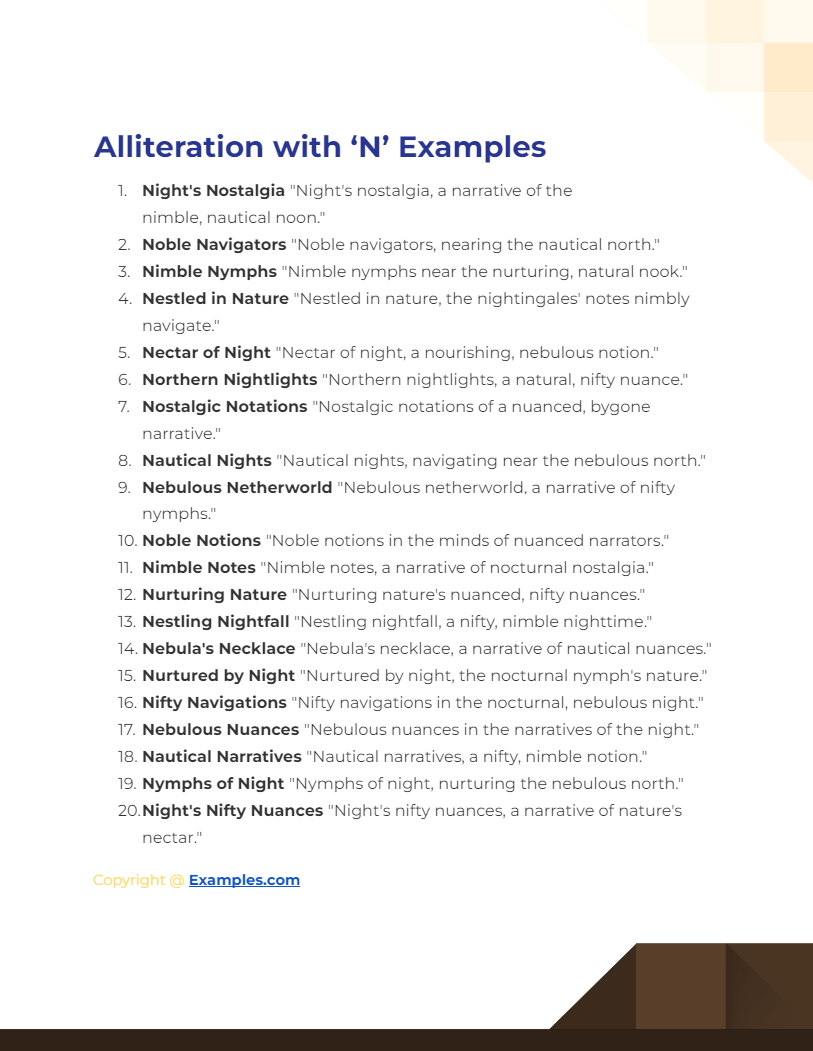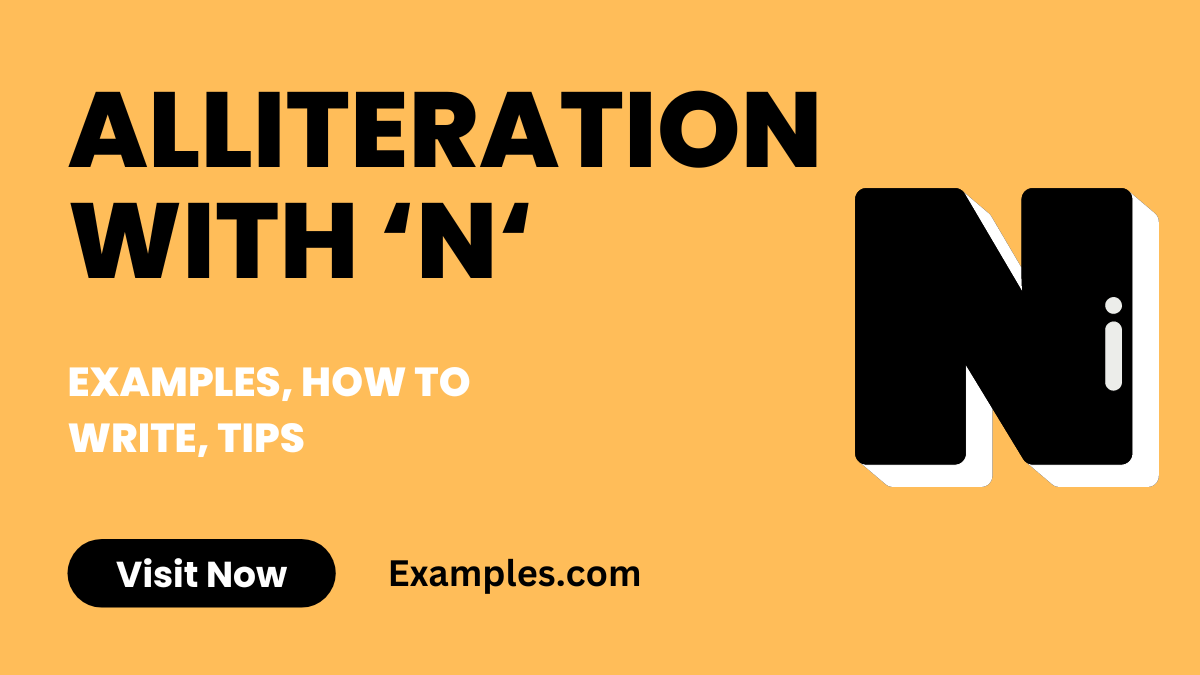Alliteration with N
Alliteration with the letter ‘N’ weaves a nuanced narrative, bringing a natural and nuanced rhythm to writing. This stylistic device, marked by the repetition of the ‘N’ sound at the beginning of words in close proximity, is a powerful tool in the arsenal of poets, storytellers, and marketers alike. It not only enhances the musicality of language but also aids in creating a vivid and lasting impression in the minds of readers or listeners. Using alliterative literature with ‘N’ can transform ordinary text into a more engaging and memorable piece. It’s particularly effective in setting a specific tone or mood, making it a favored choice in creative and persuasive writing. The gentle, often subtle sound of ‘N’ can lend a soothing and lyrical quality to compositions, enriching the reader’s experience.
Download Alliteration with 'N' Examples
Download Alliteration with 'A' to 'Z' Examples
What is the Best Example of Alliteration with ‘N’?

Example: A classic example of alliteration with the letter ‘N’ is the phrase “Nina’s noisy neighbor never stops playing the saxophone.”
Meaning: Alliteration is a literary device that involves the repetition of the same initial consonant sound in a series of words within a sentence or phrase. In the example “Nina’s noisy neighbor never stops playing the saxophone,” the consonant ‘N’ is repeated at the beginning of several words, creating a rhythmic and melodic quality to the sentence. This technique is often used in literature and poetry to add emphasis, rhythm, and musicality to the text. In this specific example, the easy alliteration repeated ‘N’ sound highlights the persistent and bothersome nature of the neighbor’s saxophone playing, making the sentence more vivid and memorable.
20 Alliteration with ‘N’ Examples

Download Alliteration with 'N' Examples in PDF
Alliteration with the letter ‘N’ navigates through nuances of language, offering a nimble and sometimes noteworthy auditory experience. The ‘N’ sound, known for its nuanced and subtle quality, is ideal for both easy and hard alliteration examples. This type of alliteration is especially effective in alliteration in rhymes, where the repetition of the ‘N’ sound adds a rhythmic and engaging dimension to verses. Here are 20 unique examples of alliteration with ‘N’, each accompanied by a creative rhyme title that captures the essence of the phrase.
- Night’s Nostalgia “Night’s nostalgia, a narrative of the nimble, nautical noon.”
- Noble Navigators “Noble navigators, nearing the nautical north.”
- Nimble Nymphs “Nimble nymphs near the nurturing, natural nook.”
- Nestled in Nature “Nestled in nature, the nightingales’ notes nimbly navigate.”
- Nectar of Night “Nectar of night, a nourishing, nebulous notion.”
- Northern Nightlights “Northern nightlights, a natural, nifty nuance.”
- Nostalgic Notations “Nostalgic notations of a nuanced, bygone narrative.”
- Nautical Nights “Nautical nights, navigating near the nebulous north.”
- Nebulous Netherworld “Nebulous netherworld, a narrative of nifty nymphs.”
- Noble Notions “Noble notions in the minds of nuanced narrators.”
- Nimble Notes “Nimble notes, a narrative of nocturnal nostalgia.”
- Nurturing Nature “Nurturing nature’s nuanced, nifty nuances.”
- Nestling Nightfall “Nestling nightfall, a nifty, nimble nighttime.”
- Nebula’s Necklace “Nebula’s necklace, a narrative of nautical nuances.”
- Nurtured by Night “Nurtured by night, the nocturnal nymph’s nature.”
- Nifty Navigations “Nifty navigations in the nocturnal, nebulous night.”
- Nebulous Nuances “Nebulous nuances in the narratives of the night.”
- Nautical Narratives “Nautical narratives, a nifty, nimble notion.”
- Nymphs of Night “Nymphs of night, nurturing the nebulous north.”
- Night’s Nifty Nuances “Night’s nifty nuances, a narrative of nature’s nectar.”
Alliteration Sentence Examples with ‘N’
Alliteration sentence examples with ‘N’ often create a nuanced, nearly hypnotic effect, using the ‘N’ sound to weave a narrative that’s both nimble and notable. This alliteration is widely used across various literary forms, including alliteration in poems, songs, and movies, for its ability to add depth and rhythm. Here are three examples:
- “Nina’s nimble fingers knitted neat, navy napkins nightly.”
- “Nestor navigated the narrow, northern narrows at night.”
- “Nancy’s new novel narrated a nostalgic, nebulous narrative.”
Alliteration Examples with ‘N’ Words
Alliteration examples using ‘N’ words demonstrate how the repetition of the ‘N’ sound can create engaging, rhythmic phrases. This form of alliteration is often utilized for its captivating quality in alliteration in songs. Here are three examples:
- “Nightly news narrated the nation’s nuanced nuances.”
- “Noble knights neared the notorious northern nest.”
- “Nina’s necklace, nestled neatly, narrated a narrative of nostalgia.”
Alliteration Examples with ‘N’ Sound
The ‘N’ sound in alliteration can produce various effects, from soft and subtle to bold and resonant. These examples show different applications of the ‘N’ sound in alliterative structures. Here are three examples:
- “Narrow, nifty, nocturnal nuances navigated the night.”
- “Nocturnal natures, nestled in nebulous nests, nurtured notions.”
- “Ned’s nautical notions navigated near the netherworld.”
Alliteration Poem with ‘N’
An alliteration poem with ‘N’ uses the repetitive ‘N’ sound to create a rhythmic and engaging experience, adding a unique lyrical quality. Here are three examples:
- “Nestled in night’s embrace, / Nature’s notes, a nectar-laced trace.”
- “Nocturnal nymphs in night’s ballet, / Neath stars that narrate their display.”
- “Near the nautical knots of time, / Night’s nuances in sweet rhyme.”
Alliteration Starting with ‘N’
Alliteration starting with ‘N’ sets a specific tone and rhythm in a phrase, creating a memorable impact. Found in various artistic expressions, including alliteration in movies, it adds a distinctive element. Here are three examples:
- “Natalie’s nuanced notions nurtured new narratives.”
- “Noisy nightingales nested near the nectarine grove.”
- “Nathan’s narrative, nestled in nuances, navigated nostalgia.”
How to Write Alliteration with ‘N’?
Writing alliteration with the letter ‘N’ involves using words that start with the ‘N’ sound in close proximity within your sentences or phrases. This consonantal alliteration can add a nuanced and sometimes narrative quality to your writing. It’s a technique used across various contexts, from poetic compositions to educational materials like alliteration for first grade. Here’s how to create effective alliteration with ‘N’:
- Understand the ‘N’ Sound: Familiarize yourself with the ‘N’ sound. It’s a soft, nasal consonant that can add a subtle rhythm to your writing.
- Select a Theme or Concept: Choose a theme or subject. This will help you find relevant ‘N’ words that fit your topic, whether you’re crafting alliteration with answers or just for creative expression.
- Brainstorm ‘N’ Words: List words beginning with ‘N’. Try to include a mix of nouns, verbs, and adjectives to enrich your alliteration.
- Construct Your Phrase or Sentence: Formulate a sentence or phrase using your chosen ‘N’ words. Aim for a natural flow that highlights the alliterative effect.
- Read Aloud for Rhythm: Alliteration’s effectiveness is often best judged when heard. Read your sentence aloud to ensure it flows well and the ‘N’ sound is pronounced clearly.
- Revise for Clarity and Impact: Make sure your alliterative phrase is clear and contributes to your overall message or story.
- Apply in Various Contexts: Whether it’s in alliteration figurative language exercises, as part of teaching alliteration for first grade, or in creative writing, adapt your use of ‘N’ alliteration to suit the purpose and audience.
Tips for Using Alliteration with ‘N’
Here are the Tips for Using Alliteration with ‘N’:
- Use Sparingly: Alliteration should enhance your writing, not dominate it. Use it to emphasize key points or add stylistic flair in moderation.
- Maintain Clarity: Your primary goal is to convey a message clearly. Alliteration should complement, not complicate, your narrative.
- Vary Word Length and Complexity: Mix short and long ‘N’ words, as well as simple and complex words, for a more dynamic textual rhythm. This is particularly important in alliteration for first grade, where simpler language is necessary.
- Consider the Mood: The ‘N’ sound is often subtle and soft. Use it in contexts where this mood is appropriate.
- Read and Revise: Reading your work aloud helps you assess the rhythm and flow. Adjust as needed to ensure the alliteration enhances the text.
- Appropriate for Audience: Tailor your alliteration to your audience. For example, alliteration for first grade should be simpler and more playful than alliteration for adults.
- Explore Different Forms: Try ‘N’ alliteration in various forms of writing, from poetry and stories to advertising and academic work, to understand its effect.
Remember, the key to effective alliteration with ‘N’ is balancing creativity with readability, ensuring that the alliterative phrases enhance rather than detract from your writing.
What is Alliteration in Literature?
Alliteration in literature refers to the repetition of the same initial consonant sounds in a series of words close to each other. This literary device is used for its rhythmic and sonic qualities, enhancing the musicality of language. Alliteration can be found across various forms of literature, including poetry, prose, and drama. It serves multiple purposes: creating mood, emphasizing certain words or themes, and making passages more memorable. Great alliteration examples can be found in works ranging from classic literature to contemporary pieces. Alliteration is also a key element in alliteration and assonance studies, where it’s analyzed for its stylistic and functional contributions to texts.
What are the Alliteration with ‘N’ for Students?
Alliteration with ‘N’ for students is a useful tool in educational settings, helping to develop language skills, including vocabulary, phonetics, and literary analysis. In teaching alliteration for students, ‘N’ alliterations can be both simple for younger learners and more complex for older students. Examples include:
- “Nina’s nine new notebooks were neatly stacked on the nightstand.”
- “Ned’s noisy neighbors never knew when to be nice.”
- “Natalie noticed numerous newts near the northern lake.”
These examples can be used in classroom activities to teach alliteration, improve linguistic awareness, and foster creativity in writing.
What is the Effect of ‘N’ Letter in Alliteration?
The effect of the ‘N’ letter in alliteration is to produce a soft, resonant sound that can add a subtle rhythm and a sense of continuity to language. The ‘N’ sound is less intrusive than harder consonants, making it ideal for creating a gentle yet persuasive auditory effect. In literature, ‘N’ alliteration is often used to create a soothing or flowing tone, making it a popular choice in both alliteration for kids and alliteration for adults. Its versatility is evident in various contexts, from playful children’s rhymes to more sophisticated literary works.
What is the Alliteration ‘N’ Type of?
Alliteration with the letter ‘N’ is a type of consonantal alliteration, where the consonant sound at the beginning of adjacent or closely connected words is repeated. It’s a common and effective literary device used across various forms of writing. The ‘N’ type of alliteration can create different effects, from soft and lyrical to more rhythmic and pronounced, depending on the context and the words chosen. This form of alliteration is seen in a wide range of literary works and is a favorite in educational materials for its appeal and effectiveness in teaching language skills, evident in alliteration for students and alliteration and assonance exercises. The ‘N’ alliteration’s ability to blend seamlessly into text makes it a versatile tool for writers and educators alike.


